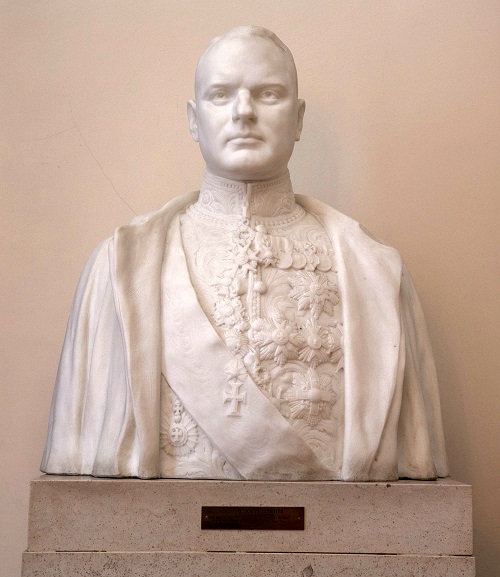
During the First World War, the diplomatic representatives of the neutral countries of the Netherlands, Spain and (until 1917) the United States in Brussels helped to organise the distribution of food in German-occupied Belgium. In doing so, they saved the population from starvation.
On 5 June 1920, towards the end of the afternoon, Émile Brunet, President of the Chamber of Representatives, collected Paul de Favereau, President of the Senate, from his home by car to take them both to the Spanish Legation in Rue Archimède.
There, they would be presenting a marble bust to Rodrigo de Saavedra y Vinent, Marquis of Villalobar, on behalf of their respective assemblies. This diplomat, who had held the title of Extraordinary Envoy and Plenipotentiary Minister with the Spanish Legation in Brussels since 1913, had endeavoured, in conjunction with his colleagues from other neutral countries (Maurits Van Vollenhoven of the Netherlands and Brand Whitlock of the United States) to advocate for Belgians with the German occupier during the war. Thanks to their efforts, the Belgian population had been able to benefit, inter alia, from food aid, which had probably literally saved numbers of lives.
On 17 December 1918, at a grand ceremony held in the Palace of the Nation in honour of these "Protective Ministers", the Offices of the Chamber and the Senate announced their decision to immortalise the gratitude of the Belgian nation by commissioning their busts.
The choice of artists was left to the diplomats themselves. In February 1919, the sculptor Godefroid Devreese (1861-1941) was informed that he had been selected by Maurits Van Vollenhoven and the Marquis of Villalobar. Brand Whitlock preferred Égide Rombaux (1865-1942).
The artists were to produce two busts (for Devreese that was therefore four in total), the first to be given to the Minister Protector and the second to be displayed in rooms in the Palace of the Nation.
In October 1919, Devreese informed the Senate that he had completed the plaster bust of the Marquis of Villalobar.
The Director General of the Belgian Senate went to the studio and stated that it was a "highly distinguished and very fine work of art" and, "what is more, very distinctive".[ 1 ] The work accurately reflected the "energy that does not shrink from any obstacle, the righteousness that stands firm in the face of brute force, and the moral superiority - the prerogative of those who champion humanity and law" - of the Marquis.[ 2 ] The moral righteousness and diplomatic stature that characterised the Marquis, despite his heavy arm and leg physical handicap, were simply yet superbly rendered.
Two copies of the bust were then carved in marble by Godefroid Devreese's craftsman, a certain Mr Van Hoof. The first bust was delivered by the sculptor to the Spanish Legation on the morning of 5 June.
It was this bust that Mr de Favereau, President of the Senate, officially presented to the Marquis on behalf of both assemblies on 5 June at 4.30 p.m., in the presence of ministers and other notables. Having expressed his thanks, the Marquis of Villalobar announced in his acceptance speech his intention to bequeath "his" bust to the Madrid Academy after his death.[ 3 ]

(1882-1976), bust by
Godefroid Devreese (1861-1941)

(1869-1934), bust by
Égide Rombaux (1865-1942)
The second was delivered to the Senate a little later, together with the busts of Maurits Van Vollenhoven and of Brand Whitlock. They are still to be found in the Senate Committees corridor.
In July 1920, Maurits van Vollenhoven was presented with his bust in Spain, where he then held a diplomatic post, and Brand Whitlock received his bust at the United States Embassy in Brussels.[ 4 ]
© Belgian Senate

